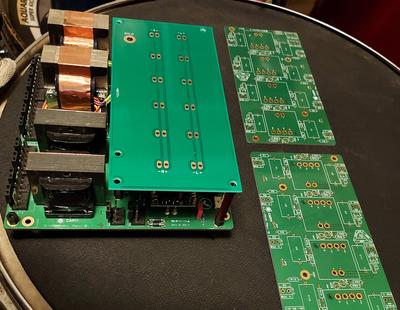JW
Well-known member
Hello,
I have a question or two that I've asked a couple times but still maybe need some help.
At the output of the 2520, in a mixing console of 32 channels, with 33K bus resistors, are we okay with a 2K pan pot? Imagine while looking at the schematic below that everything up to the output of the DOA is API. But then into the Yamaha's 2K pan pot, and the resistors to ground from the pans wiper are actually 270 ohm instead of 1.8K ohm. This gives a -4.25db pull down in the middle of pan. Am I okay here with loading? And can someone check my math in regards to total load on the output of the DOA:
8X33K program bus resistors=4.12K
6Xaux buses (33K+10K vol pot=43K) In parallel, 43K X6 =7.16K
So, 4.12K in parallel with 7.16K=total load of 2.62K
So, a 2K pan pot would be in series with this total load correct? Is this a fine load for the output of a 2520, considering the API ACA summing network would be coming after those 33K summing resistors?
I have a question or two that I've asked a couple times but still maybe need some help.
At the output of the 2520, in a mixing console of 32 channels, with 33K bus resistors, are we okay with a 2K pan pot? Imagine while looking at the schematic below that everything up to the output of the DOA is API. But then into the Yamaha's 2K pan pot, and the resistors to ground from the pans wiper are actually 270 ohm instead of 1.8K ohm. This gives a -4.25db pull down in the middle of pan. Am I okay here with loading? And can someone check my math in regards to total load on the output of the DOA:
8X33K program bus resistors=4.12K
6Xaux buses (33K+10K vol pot=43K) In parallel, 43K X6 =7.16K
So, 4.12K in parallel with 7.16K=total load of 2.62K
So, a 2K pan pot would be in series with this total load correct? Is this a fine load for the output of a 2520, considering the API ACA summing network would be coming after those 33K summing resistors?


























![Soldering Iron Kit, 120W LED Digital Advanced Solder Iron Soldering Gun kit, 110V Welding Tools, Smart Temperature Control [356℉-932℉], Extra 5pcs Tips, Auto Sleep, Temp Calibration, Orange](https://m.media-amazon.com/images/I/51sFKu9SdeL._SL500_.jpg)









